 W
WThe ARES FMG is a folding submachine gun designed by Francis J. Warin of Oak Harbor, Ohio, while he worked at Eugene Stoner's ARES Inc. Warin designed the gun for concealment and covert use, describing it as a “businessman’s personal defense weapon”. Allegedly, Warin had the idea of a defense weapon for VIPs and CEOs following the numbers of kidnappings of many of such persons in South America during the early 1980s. The FMG never entered full production.
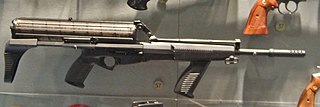 W
WThe Calico M960 is a 9×19mm Parabellum semi-automatic carbine, manufactured by Calico Light Weapons Systems. Its features include a high-capacity, cylindrical, helical-feed magazine and retractable stock. This method allows magazine capacities of 50 and 100 rounds in a relatively small space. The rear sight is mounted as part of the plastic magazine shell.
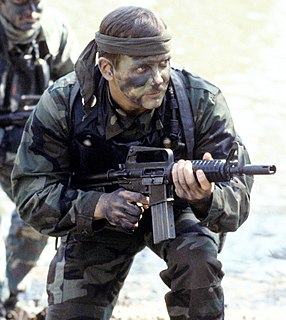 W
WThe Colt Automatic Rifle-15 or CAR-15 was a family of M16 rifle based firearms marketed by Colt in the 1960s and early 1970s. However, the term "CAR-15" is most commonly associated with the Colt Commando (AKA: XM177); these select-fire carbines have ultrashort 10.5-inch (270 mm) and 11.5-inch (290 mm) barrels with over-sized flash suppressors.
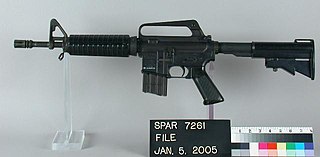 W
WThe CAR-15 XM177 or CAR-15 Commando was a part of the CAR-15 Military Weapons System designed in 1966 in response to the US military's desire for a compact M16 variant to improve on the inadequacies of earlier shortened M16 types.
 W
WThe Colt 9mm SMG, also known as the Colt Model 635 , is a 9×19mm Parabellum submachine gun manufactured by Colt, based on the M16 rifle.
 W
WThe Ingram Model 6 is a .45 ACP caliber submachine gun that was designed by Gordon B. Ingram and manufactured from 1949 through 1952 by the Police Ordnance Company of Los Angeles, California.
 W
WThe KRISS Vector is a series of weapons based upon the parent submachine gun design developed by the American company KRISS USA, formerly Transformational Defense Industries (TDI). They use an unconventional delayed blowback system combined with in-line design to reduce perceived recoil and muzzle climb.
 W
WThe Hyde-Inland M2 was a United States submachine gun design submitted for trials at Aberdeen Proving Ground in February 1941. Work was undertaken by General Motors Inland Manufacturing Division to develop workable prototypes of George Hyde's design patented in 1935. The model first submitted for trials in April 1942 was designated the Hyde-Inland 1. Trials revealed the design was superior to the M1 submachine gun in mud and dirt tests, and its accuracy in full-automatic firing was better than any other submachine gun tested at the time. An improved Hyde-Inland 2 was designated U.S. Submachine gun, Caliber .45, M2 as a substitute standard for the M1 Thompson in April 1942. As Inland's manufacturing capacity became focused on M1 carbine production, the US Army contracted M2 production to Marlin Firearms in July 1942. Marlin began production in May 1943. Marlin's production failed to match the trials prototype performance; and Marlin's original contract for 164,450 M2s was canceled in 1943 upon adoption of the M3 submachine gun. The M2 is chambered for the .45 ACP cartridge and used the same 20- or 30-round magazine as the Thompson. Its cyclic rate of fire is 570 rounds per minute. None of the approximately 400 manufactured were issued by any branches of the United States military.
 W
WThe M3 is an American .45-caliber submachine gun adopted for U.S. Army service on 12 December 1942, as the United States Submachine Gun, Cal. .45, M3. The M3 was chambered for the same .45 ACP round fired by the Thompson submachine gun, but was cheaper to produce and lighter, although, contrary to popular belief, it was less accurate. The M3 was commonly referred to as the "Grease Gun" or simply "the Greaser", owing to its visual similarity to the mechanic's tool.
 W
WThe .45 Reising submachine gun was manufactured by Harrington & Richardson (H&R) Arms Company in Worcester, Massachusetts, USA, and was designed and patented by Eugene Reising in 1940. The three versions of the weapon were the Model 50, the folding stock Model 55, and the semiautomatic Model 60 rifle. Over 100,000 Reisings were ordered during World War II, and were initially used by the United States Navy, Marine Corps, and the United States Coast Guard, though some were shipped to Canadian, Soviet, and other allied forces to fight the Axis powers.
 W
WThe Military Armament Corporation Model 10, officially abbreviated as "M10" or "M-10", and more commonly known as the MAC-10, is a compact, blowback operated machine pistol/submachine gun that was developed by Gordon B. Ingram in 1964. It is chambered in either .45 ACP or 9mm. A two-stage suppressor by Sionics was designed for the MAC-10, which not only abates the noise created, but makes it easier to control on full automatic. For a decade, the semi-automatic pistol version of the weapon was forbidden in the U.S. under the assault weapons ban enacted by Congress in 1994.
 W
WThe Ingram MAC-11 is a subcompact machine pistol/submachine gun developed by American gun designer Gordon Ingram at the Military Armament Corporation (MAC) during the 1970s in Powder Springs, Georgia. The weapon is a sub-compact version of the Model 10 (MAC-10), and is chambered to fire the smaller .380 ACP round.
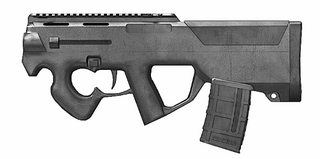 W
WThe Magpul PDR is a prototype bullpup-style 5.56×45mm NATO carbine unveiled by Magpul Industries in 2006. Although halted in development as of 2011 it has garnered some attention, largely due to its "futuristic" appearance. The system consists of a gas-operated bullpup carbine intended to replace some submachine guns, M9 pistols and M4 carbines while still offering the rapid fire and range of an M4 carbine in an ultra compact firearm.
 W
WThe Smith & Wesson M76 submachine gun (SMG) was produced by Smith & Wesson from 1967 to 1974.
 W
WThe Thompson submachine gun is a blowback-operated, air-cooled, magazine-fed selective-fire submachine gun, invented by the United States Army Brigadier general John T. Thompson in 1918. It was originally designed to break the stalemate of trench warfare of World War I, but was not finished until after the war ended.
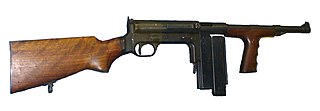 W
WThe United Defense M42, sometimes known as the Marlin for the company that did the actual manufacturing, was an American submachine gun used during World War II. It was produced from 1942 to 1943 by United Defense Supply Corp. for possible issue as a replacement for the Thompson submachine gun and was used by agents of the Office of Strategic Services (OSS). However, its usage was limited, and the Thompson continued to see service until the end of the war, alongside the M3 submachine gun, which was designed around the same time as the M42.